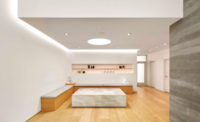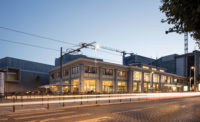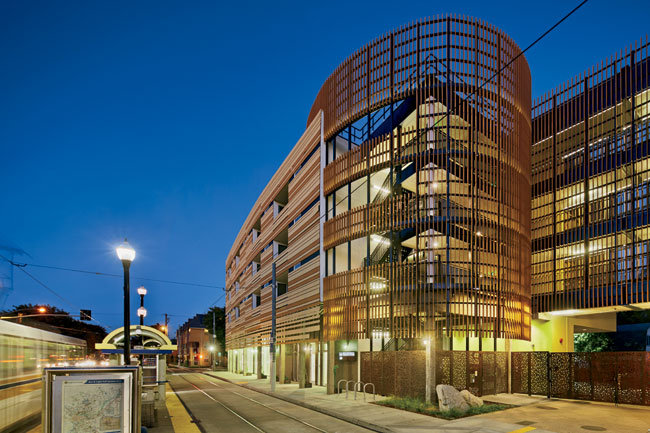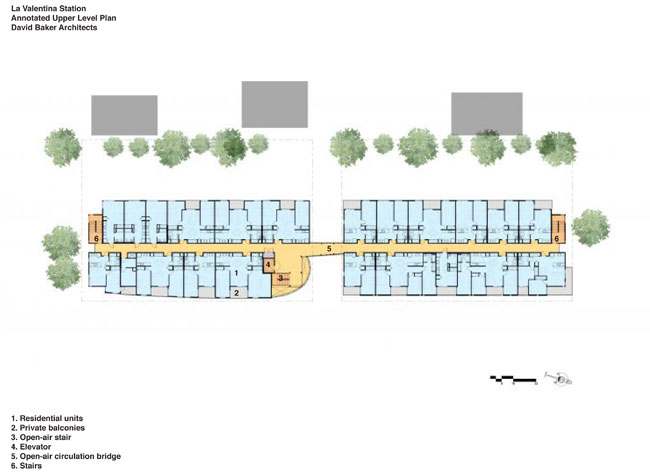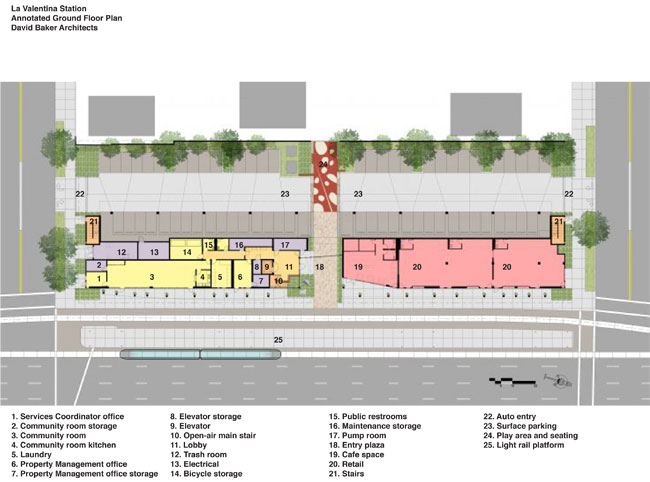La Valentina Station
Downtown Catalyst






2 Private Balconies
3 Open-air Stair
4 Elevator
5 Open-air Bridge










Architects & Firms
Sacramento, CA
After designing 44 affordable-housing projects over the last 30 years, San Francisco architect David Baker has developed a formula for making them look like their market-rate cousins: “You build 20 percent with high-end materials, and the other 80 percent with less expensive ones. But they must be used creatively,” he says. “It's kind of like competing on Iron Chef—you make the most of what you have.” At La Valentina Station, a 63-unit, transit-oriented housing project in Sacramento, California, Baker applied this culinary-style innovation to a highly visible site three blocks north of City Hall, next to a light-rail station and a busy arterial route.
The architect employed an inexpensive, recylable polyvinylchloride (PVC) rainscreen over cement board, painted to create a lively striped facade, with curved PVC slatwork wrapping around a four-story exterior stairwell. He then supplemented the lower-priced materials with ornately patterned, water-jet-cut Cor-Ten steel for the balcony fronts and fencing. The $12.3 million mixed-use wood-frame and concrete-deck structure, which includes space for ground-level retail and a corner caf', cost only $162 per square foot. Completed last summer, it was soon filled with an energetic mix of young families and singles who qualified for the low-income housing.
The 1-acre site, formerly occupied by auto-body shops, had been vacant for 20 years and had become a destination for drug dealers when the city's Housing and Redevelopment Agency put out a request for proposals in 2007. The winner was Domus Development, headed by Meea Kang, who has an M.Arch. from the University of California, Berkeley. With her 17-year track record in building private affordable housing, Kang had often admired Baker's accomplishments in this area. While she originally planned to include some market-rate housing, the recession prompted her to drop that component; in a tight economy, she managed to fund the project through state low-income-housing tax credits and obtained financing from the city's redevelopment agency and local banks.
Since the rectilinear lot, like most Sacramento blocks, had an alley severing its middle, Baker created a structure of elevated walkways to bridge the gap and link the two linear housing blocks in the complex. The elevated “streets” are high enough to provide clearance for emergency vehicles at ground level; otherwise the alleyway, covered in a soft-fall surface, serves as a play area.
The interior floor plans feature typical double-loaded corridors, although the key circulation routes, including the main stairwell, are open-air. While this may be unusual for the hot climate of Sacramento, it reflects the design's emphasis on sustainability. To make the most of natural ventilation and lighting, the majority of the apartments, which range from 440-square-foot studios to 1,000-square-foot three-bedroom units, have private balconies, recessed for shade. Solar electricity and hot-water systems, along with other measures, allow the building to exceed California's stringent Title 24 energy-efficiency standards by 30 percent.
The occupants make only 30 to 60 percent of the area's median income and pay rents ranging from $347 to $1,100 a month, depending on income and the size of the unit. The pride that the burgeoning community has in its new home is apparent, from the care that people take to keep communal areas neat to the plants and furniture they place on their balconies. Both the developer and the architect also feel enriched by their efforts to improve the design level of Sacramento's oldest neighborhood. “People notice the neighborhood in a good way now,” says Baker. “It's an exclamation point on the street.”
People
Formal name of building:
Location:
Completion Date:
Gross square footage:
Total construction cost:
Owner/Developer:
Architect:
Personnel in architect's firm who should receive special credit:
Landscape Architect:
Landscape Consultant:
General contractor:
Photographer:
Renderer:
CAD system, project management, or other software used:
Project website: |
Products
Exterior cladding Rainscreen: Azek Other cladding unique to this project: James Hardie Panel Siding
Roofing
Windows
Doors Metal doors: DKS Wood doors: T.M. Cobb Sliding doors: Vinyl: Milgard Fire-control doors, security grilles: I.R. Steelcraft Upswinging doors, other: Sectional doors: Wayne Dalton; Parking gate operator: Hysecurity Slide Smart
Hardware Closers: LCN Pulls: Schlage
Interior finishes Suspension grid: USG Cabinetwork and custom woodwork: Lanz Cabinets; custom millwork in lobby: Burnett & Sons, Finey, Terramai Paints and stains: Frazee, Kelly Moore Plastic laminate: Formica Floor and wall tile: Public bathrooms: Dal Tile Resilient flooring: Common laundry and utility areas: Mannington VCT; Unit baths: Armstrong Cushion Step; Unit kitchens: Mannington Adura Carpet: Corridors: Bigelow Broadloom; units: Shaw Eco Ultimate II
Lighting Corridor recesses, community space, and bridge: Del Ray Downlight: Cooper LED Decks: Stonco Outdoor at rainscreen: Deco Lighting
Conveyance
Energy |


